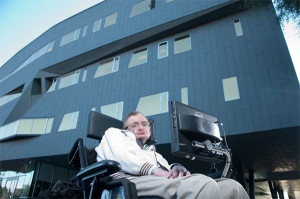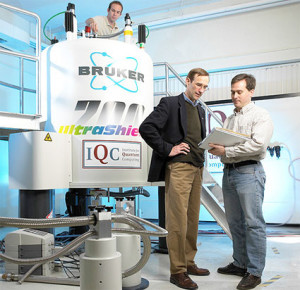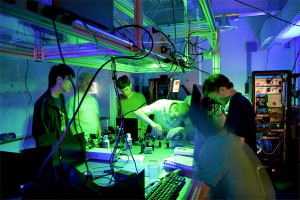Thanks to Bob Yirka’s September 30, 2020 article for phys.org there’s an announcement about D-Wave Systems’ latest quantum computer and an explanation of how D-Wave’s quantum computer differs from other quantum computers. Here’s the explanation (Note: Links have been removed),
…
Over the past several years, several companies have dedicated resources to the development of a true quantum computer that can tackle problems conventional computers cannot handle. Progress on developing such computers has been slow, however, especially when compared with the early development of the conventional computer. As part of the research effort, companies have taken different approaches. Google and IBM, for example, are working on gate-model quantum computer technology, in which qubits are modified as an algorithm is executed. D-Wave, in sharp contrast, has been focused on developing so-called annealer technology, in which qubits are cooled during execution of an algorithm, which allows for passively changing their value.
Comparing the two is next to impossible because of their functional differences. Thus, using 5,000 qubits in the Advantage system does not necessarily mean that it is any more useful than the 100-qubit systems currently being tested by IBM or Google. Still, the announcement suggests that businesses are ready to start taking advantage of the increased capabilities of quantum systems. D-Wave notes that several customers are already using their system for a wide range of applications. Menten AI, for example, has used the system to design new proteins; grocery chain Save-On-Foods has been using it to optimize business operations; Accenture has been using it to develop business applications; Volkswagen has used the system to develop a more efficient car painting system.
…
Here’s the company’s Sept. 29, 2020 video announcement,
For those who might like some text, there’s a Sept. 29, 2020 D-Wave Systems press release (Note: Links have been removed; this is long),
D-Wave Systems Inc., the leader in quantum computing systems, software, and services, today [Sept. 29, 2020] announced the general availability of its next-generation quantum computing platform, incorporating new hardware, software, and tools to enable and accelerate the delivery of in-production quantum computing applications. Available today in the Leap™ quantum cloud service, the platform includes the Advantage™ quantum system, with more than 5000 qubits and 15-way qubit connectivity, in addition to an expanded hybrid solver service that can run problems with up to one million variables. The combination of the computing power of Advantage and the scale to address real-world problems with the hybrid solver service in Leap enables businesses to run performant, real-time, hybrid quantum applications for the first time.
As part of its commitment to enabling businesses to build in-production quantum applications, the company announced D-Wave Launch™, a jump-start program for businesses who want to get started building hybrid quantum applications today but may need additional support. Bringing together a team of applications experts and a robust partner community, the D-Wave Launch program provides support to help identify the best applications and to translate businesses’ problems into hybrid quantum applications. The extra support helps customers accelerate designing, building, and running their most important and complex applications, while delivering quantum acceleration and performance.
The company also announced a new hybrid solver. The discrete quadratic model (DQM) solver gives developers and businesses the ability to apply the benefits of hybrid quantum computing to new problem classes. Instead of accepting problems with only binary variables (0 or 1), the DQM solver uses other variable sets (e.g. integers from 1 to 500, or red, yellow, and blue), expanding the types of problems that can run on the quantum computer. The DQM solver will be generally available on October 8 [2020].
With support for new solvers and larger problem sizes backed by the Advantage system, customers and partners like Menten AI, Save-On-Foods, Accenture, and Volkswagen are building and running hybrid quantum applications that create solutions with business value today.
- Protein design pioneer Menten AI has developed the first process using hybrid quantum programs to determine protein structure for de novo protein design with very encouraging results often outperforming classical solvers. Menten AI’s unique protein designs have been computationally validated, chemically synthesized, and are being advanced to live-virus testing against COVID-19.
- Western Canadian grocery retailer Save-On-Foods is using hybrid quantum algorithms to bring grocery optimization solutions to their business, with pilot tests underway in-store. The company has been able to reduce the time an important optimization task takes from 25 hours to a mere 2 minutes of calculations each week. Even more important than the reduction in time is the ability to optimize performance across and between a significant number of business parameters in a way that is challenging using traditional methods.
- Accenture, a leading global professional services company, is exploring quantum, quantum-inspired, and hybrid solutions to develop applications across industries. Accenture recently conducted a series of business experiments with a banking client to pilot quantum applications for currency arbitrage, credit scoring, and trading optimization, successfully mapping computationally challenging business problems to quantum formulations, enabling quantum readiness.
- Volkswagen, an early adopter of D-Wave’s annealing quantum computer, has expanded its quantum use cases with the hybrid solver service to build a paint shop scheduling application. The algorithm is designed to optimize the order in which cars are being painted. By using the hybrid solver service, the number of color switches will be reduced significantly, leading to performance improvements.
The Advantage quantum computer and the Leap quantum cloud service include:
- New Topology: The topology in Advantage makes it the most connected of any commercial quantum system in the world. In the D-Wave 2000Q™ system, qubits may connect to 6 other qubits. In the new Advantage system, each qubit may connect to 15 other qubits. With two-and-a-half times more connectivity, Advantage enables the embedding of larger problems with fewer physical qubits compared to using the D-Wave 2000Q system. The D-Wave Ocean™ software development kit (SDK) includes tools for using the new topology. Information on the topology in Advantage can be found in this white paper, and a getting started video on how to use the new topology can be found here.
- Increased Qubit Count: With more than 5000 qubits, Advantage more than doubles the qubit count of the D-Wave 2000Q system. More qubits and richer connectivity provide quantum programmers access to a larger, denser, and more powerful graph for building commercial quantum applications.
- Greater Performance & Problem Size: With up to one million variables, the hybrid solver service in Leap allows businesses to run large-scale, business-critical problems. This, coupled with the new topology and more than 5000 qubits in the Advantage system, expands the complexity and more than doubles the size of problems that can run directly on the quantum processing unit (QPU). In fact, the hybrid solver outperformed or matched the best of 27 classical optimization solvers on 87% of 45 application-relevant inputs tested in MQLib. Additionally, greater connectivity of the QPU allows for more compact embeddings of complex problems. Advantage can find optimal solutions 10 to 30 times faster in some cases, and can find better quality solutions up to 64% percent of the time, when compared to the D-Wave 2000Q LN QPU.
- Expansion of Hybrid Software & Tools in Leap: Further investments in the hybrid solver service, new solver classes, ease-of-use, automation, and new tools provide an even more powerful hybrid rapid development environment in Python for business-scale problems.
- Flexible Access: Advantage, the expanded hybrid solver service, and the upcoming DQM solver are available in the Leap quantum cloud service. All current Leap customers get immediate access with no additional charge, and new customers will benefit from all the new and existing capabilities in Leap. This means that developers and businesses can get started today building in-production hybrid quantum applications. Flexible purchase plans allow developers and forward-thinking businesses to access the D-Wave quantum system in the way that works for them and their business.
- Ongoing Releases: D-Wave continues to bring innovations to market with additional hybrid solvers, QPUs, and software updates through the cloud. Interested users and customers can get started today with Advantage and the hybrid solver service, and will benefit from new components of the platform through Leap as they become available.
“Today’s general availability of Advantage delivers the first quantum system built specifically for business, and marks the expansion into production scale commercial applications and new problem types with our hybrid solver services. In combination with our new jump-start program to get customers started, this launch continues what we’ve known at D-Wave for a long time: it’s not about hype, it’s about scaling, and delivering systems that provide real business value on real business applications,” said Alan Baratz, CEO, D-Wave. “We also continue to invest in the science of building quantum systems. Advantage was completely re-engineered from the ground up. We’ll take what we’ve learned about connectivity and scale and continue to push the limits of innovation for the next generations of our quantum computers. I’m incredibly proud of the team that has brought us here and the customers and partners who have collaborated with us to build hundreds of early applications and who now are putting applications into production.”
“We are using quantum to design proteins today. Using hybrid quantum applications, we’re able to solve astronomical protein design problems that help us create new protein structures,” said Hans Melo, Co-founder and CEO, Menten AI. “We’ve seen extremely encouraging results with hybrid quantum procedures often finding better solutions than competing classical solvers for de novo protein design. This means we can create better proteins and ultimately enable new drug discoveries.”
“At Save-On-Foods, we have been committed to bringing innovation to our customers for more than 105 years. To that end, we are always looking for new and creative ways to solve problems, especially in an environment that has gotten increasingly complex,” said Andrew Donaher, Vice President, Digital & Analytics at Save-On-Foods. “We’re new to quantum computing, and in a short period of time, we have seen excellent early results. In fact, the early results we see with Advantage and the hybrid solver service from D-Wave are encouraging enough that our goal is to turn our pilot into an in-production business application. Quantum is emerging as a potential competitive edge for our business.“
“Accenture is committed to helping our clients prepare for the arrival of mainstream quantum computing by exploring relevant use cases and conducting business experiments now,” said Marc Carrel-Billiard, Senior Managing Director and Technology Innovation Lead at Accenture. “We’ve been collaborating with D-Wave for several years and with early access to the Advantage system and hybrid solver service we’ve seen performance improvements and advancements in the platform that are important steps for helping to make quantum a reality for clients across industries, creating new sources of competitive advantage.”
“Embracing quantum computing is nothing new for Volkswagen. We were the first to run a hybrid quantum application in production in Lisbon last November with our bus routing application,” said Florian Neukart, Director of Advanced Technologies at Volkswagen Group of America. “At Volkswagen, we are focusing on building up a deep understanding of meaningful applications of quantum computing in a corporate context. The D-Wave system gives us the opportunity to address optimization tasks with a large number of variables at an impressive speed. With this we are taking a step further towards quantum applications that will be suitable for everyday business use.”
I found the description of D-Wave’s customers and how they’re using quantum computing to be quite interesting. For anyone curious about D-Wave Systems, you can find out more here. BTW, the company is located in metro Vancouver (Canada).
 History has repeatedly demonstrated the power of research in physics to transform society. As a student of history and a believer in the power of physics, Mike Lazaridis set out in 2000 to make real his bold vision to establish the Region of Waterloo as a world leading centre for physics research. That is, a place where the best researchers in the world would come to do cutting-edge research and to collaborate with each other and in so doing, achieve transformative discoveries that would lead to the commercialization of breakthrough technologies.
History has repeatedly demonstrated the power of research in physics to transform society. As a student of history and a believer in the power of physics, Mike Lazaridis set out in 2000 to make real his bold vision to establish the Region of Waterloo as a world leading centre for physics research. That is, a place where the best researchers in the world would come to do cutting-edge research and to collaborate with each other and in so doing, achieve transformative discoveries that would lead to the commercialization of breakthrough technologies. Perimeter is located in a Governor-General award winning designed building in Waterloo. Success in recruiting and resulting space requirements led to an expansion of the Perimeter facility. A uniquely designed addition, which has been described as space-ship-like, was opened in 2011 as the
Perimeter is located in a Governor-General award winning designed building in Waterloo. Success in recruiting and resulting space requirements led to an expansion of the Perimeter facility. A uniquely designed addition, which has been described as space-ship-like, was opened in 2011 as the  Mike and Doug Fregin have been close friends since grade 5. They are also co-founders of BlackBerry (formerly Research In Motion Limited). Doug shares Mike’s passion for physics and supported Mike’s efforts at the Perimeter Institute with an initial gift of $10 million. Since that time Doug has donated a total of $30 million to Perimeter Institute. Separately, Doug helped establish the
Mike and Doug Fregin have been close friends since grade 5. They are also co-founders of BlackBerry (formerly Research In Motion Limited). Doug shares Mike’s passion for physics and supported Mike’s efforts at the Perimeter Institute with an initial gift of $10 million. Since that time Doug has donated a total of $30 million to Perimeter Institute. Separately, Doug helped establish the  For many years, theorists have been able to demonstrate the transformative powers of quantum mechanics on paper. That said, converting these theories to experimentally demonstrable discoveries has, putting it mildly, been a challenge. Many naysayers have suggested that achieving these discoveries was not possible and even the believers suggested that it could likely take decades to achieve these discoveries. Recently, a buzz has been developing globally as experimentalists have been able to achieve demonstrable success with respect to Quantum Information based discoveries. Local experimentalists are very much playing a leading role in this regard. It is believed by many that breakthrough discoveries that will lead to commercialization opportunities may be achieved in the next few years and certainly within the next decade.
For many years, theorists have been able to demonstrate the transformative powers of quantum mechanics on paper. That said, converting these theories to experimentally demonstrable discoveries has, putting it mildly, been a challenge. Many naysayers have suggested that achieving these discoveries was not possible and even the believers suggested that it could likely take decades to achieve these discoveries. Recently, a buzz has been developing globally as experimentalists have been able to achieve demonstrable success with respect to Quantum Information based discoveries. Local experimentalists are very much playing a leading role in this regard. It is believed by many that breakthrough discoveries that will lead to commercialization opportunities may be achieved in the next few years and certainly within the next decade.